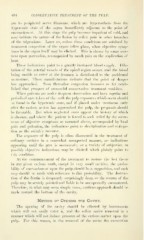Page 406 - My FlipBook
P. 406
404 CONSERVATIVE TREATMENT OF THE PULP.
are its peripheral nerve filaments, which :ire hyperesthetic from the
hypercmic state of the organ immediately adjacent to the point of
encroacinnent. At this stage the pulp becomes im])atient of cold, and
may indicate the nature of the lesion by reflex pain in other branches
of the trigeminus. I^ater on, nnless these conditions are subdued by
treatment congestion of the organ takes place, when objective symp-
toms in the organ itself may be elicited. This is shown by some sore-
ness upon percussion, accompanied by much pain on the application of
heat.
These indications point to a greatly increased blood su])[)ly. Dihi-
tation of the arterial vessels of the apical region occurs, and the blood
being unable to enter at the foramen is distributed to the peridental
membrane. These manifestations indicate that the point of danger
has approached. Soon thereafter congestion becomes so far estab-
lished that prospect of successful conservative treatment vanishes.
When patients are under frequent observation and have regular and
periodical care taken of the teeth the pulp exposui'es which occur should
be found in the hyperemic state, and if ])laced under treatment early
after the carious action has approached the pulp, the prognosis should
be favorable. But when neglected cases appear the history of which
is obscure, and where the patient is forced to seek relief by the occur-
rence of objective symptoms as narrated above, accompanied by local
pain and pulsation, the indications point to devitalization and extirpa-
tion as the suitable recourse.
The exposure of the pulp is often discovered in the treatment of
ordinary cavities in a somewhat unexpected manner, no indications
appearing nntil the part is uncovered ; or a variety of subjective or
possibly objective indications may be elicited which plainly point to
this condition.
At the commencement of the treatment to restore the lost tissue
in any given carious tooth, except in very small cavities, the })roba-
bility of encroachment upon the pulp should be a supposition, and each
step should be made with reference to this probability. The destruc-
tion of the dentin is frequently surprisingly deep, or the cornua of the
pulp may be acutely pointed and liable to be unexpectedly encountered.
Therefore, in what may seem simple cases, cautious approach should be
made toward the bottom of the cavity.
Method of Opening the Cavity.
The opening of the cavity should be effected by instruments
which will not easily enter it, and the softer caries removed in a
manner which will not induce pressure of the carious matter upon the
pulp. For this reason, in the removal of the caries the excavation


